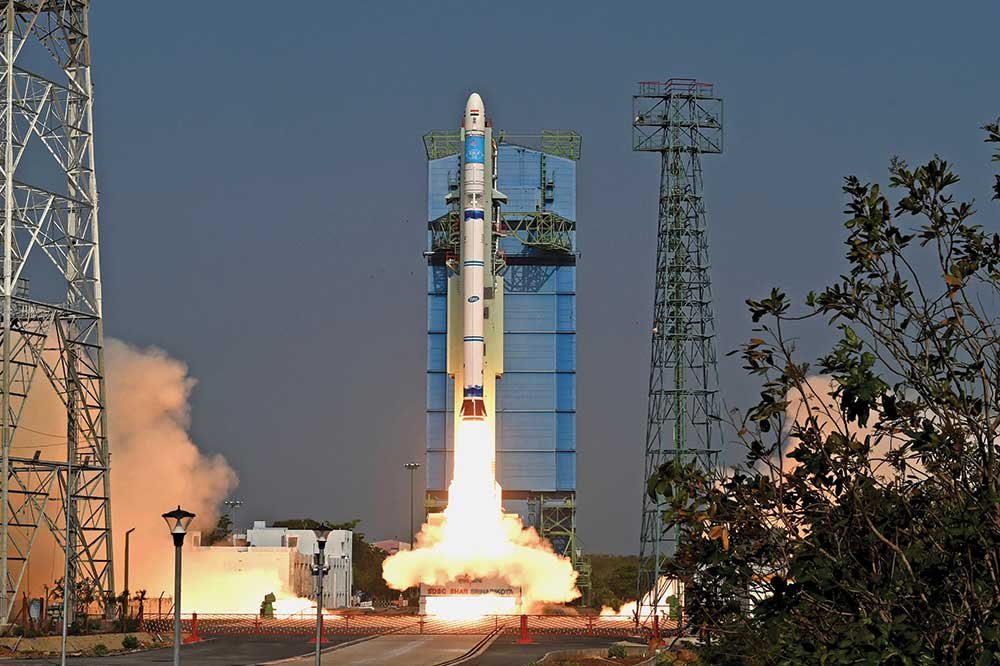The Indian National Space Promotion and Authorisation Centre (IN-SPACe) is an independent and autonomous agency under the Department of Space (DoS). It is tasked with promoting, enabling, authorising, and supervising the space activities of Non-Governmental Entities (NGEs) in India. IN-SPACe is a single-window interface between ISRO and private players, facilitating their active participation in the Indian space ecosystem. The organisation primarily focuses on fostering the growth of India’s space industry.
In May 2025, the Chairman of IN-SPACe announced that India plans to launch 52 spy satellites over the next five years under the Space-Based Surveillance-3 (SBS-3) programme. This plan was also revealed by the Chief of Defence Staff (CDS) while addressing the Indian DefSpace Symposium 2025. This ambitious initiative underscores the increasing involvement of private industry in establishing the country’s strategic satellite network. Of these, nearly 25 to 26 satellites are expected to be developed and delivered by private companies, a significant milestone that marks a major boost for India’s space sector.
It is important to recognise this programme as a test case on how private industry could assist the military in the domain of space. At the same time, this is a strategic initiative, and its implications must be assessed through a broader national security and geopolitical lens, rather than merely from a commercial standpoint. This proposal to launch a constellation of 52 satellites over the next five years to enhance its space-based surveillance capabilities aims to bolster the surveillance capabilities of the Indian Army, Navy, and Air Force. This satellite network would enable the Indian armed forces to track enemy movements, monitor borders, and improve real-time coordination during military operations. India is actively enhancing its space-based surveillance capabilities through this proposed network under the SBS-3 programme.
This strategic initiative is expected to be based on the critical lessons learned from recent military operations globally, most notably India’s Operation Sindoor. Today, we know about the existing gaps in India’s space domain capabilities and what needs to be done to develop and design a future-ready military space architecture. The focus appears to be on developing a layered satellite surveillance network aimed at providing comprehensive geo-intelligence, monitoring potential threats from space.
The third phase of India’s space-based surveillance programme is expected to be based on the joint contribution from the Indian Space Research Organisation and India’s private space sector. Companies like Ananth Technologies, Centum Electronics, and Alpha Design Technologies have collaborated with ISRO earlier
Collaboration with ISRO
The third phase of India’s space-based surveillance programme is expected to be based on the joint contribution from the Indian Space Research Organisation (ISRO) and India’s private space sector. Companies like Ananth Technologies, Centum Electronics, and Alpha Design Technologies are known to be collaborating with ISRO. The constellation is expected to be operational by the end of 2026.
ISRO has developed the Small Satellite Launch Vehicle (SSLV) to deliver payloads of up to 500 kg to low Earth orbit (LEO) at an altitude of 500 km. This vehicle is capable of delivering up to 300 kg to a Sun-synchronous orbit (SSO) at the same altitude. Key features of the SSLV include low cost, a quick turnaround time of approximately 72 hours or less (as per some reports, it could even be 24 hours), flexibility in accommodating multiple satellites, and minimal launch infrastructure requirements. The vehicle has undergone successful test launches.
Recently, ISRO identified Hindustan Aeronautics Limited (HAL) as the agency for the technology transfer of the Small Satellite Launch Vehicle (SSLV), marking a significant milestone in India’s journey toward space commercialization. HAL has been awarded the full contract to manufacture, market, and launch the SSLV. It is important to note that HAL had previously secured a contract for the production of the Polar Satellite Launch Vehicle (PSLV), in partnership with Larsen & Toubro .
SBS-3 aims to provide comprehensive geo-intelligence, enabling India to monitor activities on Earth, including those from other satellites, with increased precision, agility, and responsiveness. The project operates under a compressed timeline, with full deployment expected by the end of 2026, driven by the urgent security needs to counter potential threats in space. This advanced space-based surveillance network is a key element in India’s broader efforts to enhance national security capabilities, especially amid shifting geopolitical dynamics and the increasing militarisation of space.
Realising the importance of satellite technologies for the armed forces, around 2008, a ‘Space Cell’ was created by the Indian government in the office of the ‘Integrated Defence Service’ (IDS). The purpose was to provide the necessary coordination for any requests to use Indian space assets for support of Intelligence, Surveillance, and Reconnaissance (ISR) objectives in the domain of security. During 2019, the Defence Space Agency (DSA), a tri-services agency, was established to operate and protect India’s space assets and interests. This agency spearheads India’s military space agenda today.
SBS-3 is the third phase of India’s Space-Based Surveillance (SBS) programme. The previous two phases played a significant role in supporting the Indian Armed Forces with critical intelligence inputs. SBS-1, launched in 2001, included four satellites of the Cartosat and RISAT series. Its primary objective was to monitor activities along India’s borders and key military installations of adversaries. SBS-2, launched in 2013, expanded these surveillance capabilities, particularly in maritime domain awareness, by incorporating additional remote-sensing satellites into the surveillance network.
India is rapidly advancing its space security capabilities, driven by the growing importance of space as a critical domain for national defence and the increasing militarisation of space globally. Recognising the need for secure and reliable communication across its armed forces, India has already taken key steps in this direction. The Indian Navy and Indian Air Force currently benefit from dedicated satellites launched by ISRO.
ISRO will transfer SSLV technology to the private sector. Six companies are working to acquire this technology, while at least ten companies and consortia have expressed interest in manufacturing the vehicle
Risk of Blind Spots
Meanwhile, the Indian Army is also expected to receive its dedicated satellite in the near future. However, much more needs to be done in this field. In June 2025, former ISRO chief S Somanath warned that without a massive satellite boost, India’s armed forces risk blind spots in a crisis. According to him, space has emerged as the decisive domain for national defence. Today, threats from hypersonic weapons have become a reality. Recently, the US announced that it will create around 500-satellite constellations for its Golden Dome programme.

In India’s case, the military would require hundreds of satellites to meet the demands of real-time defence surveillance. Also, from the perspective of any missile defence system, which requires addressing not only the ICBM threat but also a hypersonic missile threat, more than 50% of the space-based systems would be needed to build a missile defence architecture.
The modern-day battlefield is rapidly evolving, with space emerging as a critical domain for national security. In this context, India’s SBS-3 programme represents an important, yet limited, step towards securing the country’s strategic interests. While SBS-3 builds upon earlier phases to enhance surveillance capabilities, the current satellite network remains minimal when measured against the scale and complexity of India’s security challenges. With growing threats such as hypersonic missiles, cross-border terrorism, and maritime vulnerabilities, a more robust and comprehensive satellite constellation is essential.
The need of the hour is a dense network of defence-specific satellites that can offer real-time intelligence, persistent surveillance, and early warning capabilities across all terrains and domains. To keep pace with global military advancements and ensure self-reliance in crisis scenarios, India must significantly expand and upgrade its space surveillance infrastructure under future phases of the SBS programme.
– The writer is a Deputy Director General with MP-IDSA, New Delhi. The views expressed are of the writer and do not necessarily reflect the views of Raksha Anirveda






